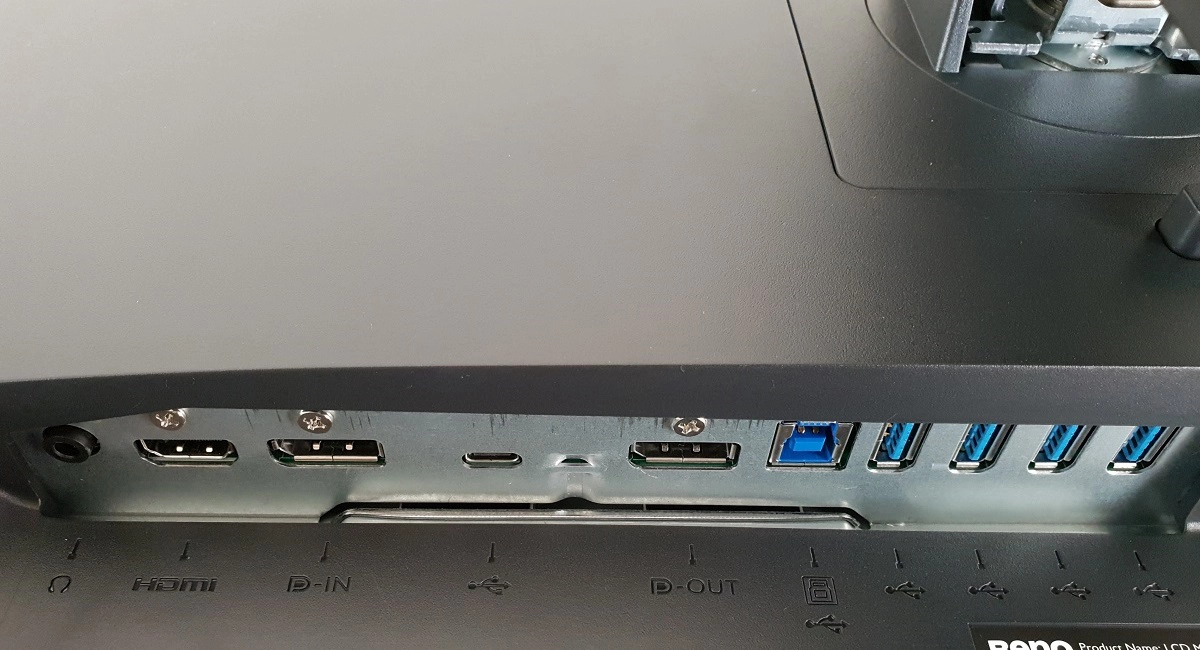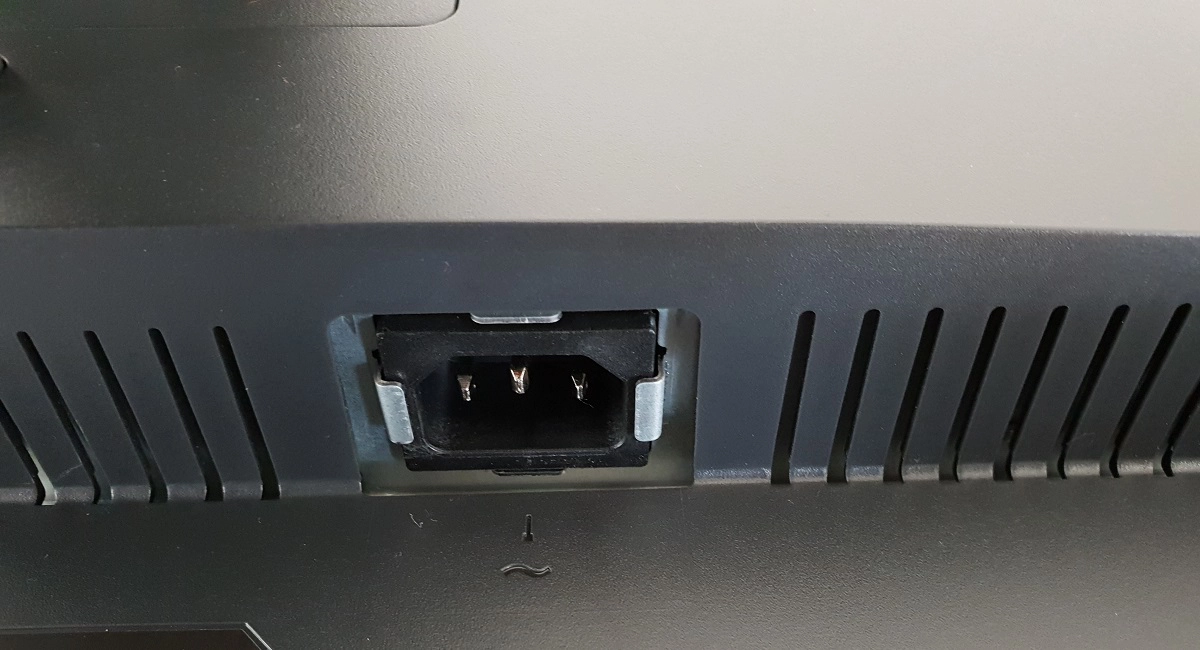Author: Adam Simmons
Date published: July 27th 2020
Table of Contents
Introduction
For productivity purposes the 2560 x 1440 (WQHD) resolution and 27” screen size can be an attractive combination. Whilst an increasing number of models focus on elevated refresh rate as well, the BenQ PD ‘DesignVue Designer Monitor’ series focuses instead on a solid 60Hz experience. The BenQ PD2705Q is one such model, focused on accurate colour output within the sRGB colour space. We put this monitor to the test using our usual varied test scenarios.
Specifications
The monitor uses a 27” LG Display AH-IPS panel with a 60Hz refresh rate and support for true 8-bit colour. A 5ms response time is specified, which as usual you shouldn’t pay too much attention to. Some of the key ‘talking points’ for this monitor have been highlighted in blue below.
The monitor has a smart home-office appearance from the front, with a moderately thick dark grey matte plastic bottom bezel. This includes a central ambient light sensor for the ‘Bright Intelligence’ feature, explored in the OSD (On Screen Display) video shortly. The bottom bezel is ~21mm (0.83 inches) or ~36mm (1.43 inches) including the sensor. The top and side bezels are much slimmer, with a dual-stage design that includes a slender panel border flush with the rest of the screen. Plus a slim hard plastic outer component. Including both components, the bezels here are ~7mm (0.28 inches). The screen has a very light matte anti-glare finish, as explored shortly. The monitor is mainly matte black plastic at the rear, with some ventilation holes toward the top. The stand attaches centrally using a quick release mechanism, with a button beneath the attachment point. Removing this reveals 100 x 100mm VESA holes for alternative mounting. Towards the bottom of the stand neck there is a cable-tidy loop, with dark blue satin plastic inner ring. Towards the right side of the screen there’s a K-Slot. The ports face downwards and include; a 3.5mm headphone jack, HDMI 2.0, DP 1.4, USB-C (65W PD, DP Alt Mode, upstream data), DP out (for MST daisy chaining), 4 USB 3.1 ports (plus upstream) and an AC power input (internal power converter). KVM functionality is included, allowing connected USB peripherals to be shared between multiple systems. 2 x 2W speakers are also included, offering basic and not particularly high-quality sound output. The native 2560 x 1440 @60Hz plus HDR functionality is supported via DP 1.4 and HDMI 2.0. A power cable, DP cable, USB-C cable and USB cable is included as standard. An HDMI cable may also be included, depending on region and retailer. 60Hz is the only listed refresh rate at the native resolution. The standard refresh rates listed at certain lower resolutions (‘Ultra HD, HD, SD’ list) are more comprehensive and identical via suitable versions of HDMI and DP. These are mainly designed for use when the monitor is connected to devices such as games consoles that don’t generally support the native WQHD resolution. A ‘4 x 2k, 3840 x 2160’ mode is also included, downsampling the ‘4K’ UHD resolution with the same supported refresh rates as the Full HD resolution. This is useful for devices such as some games consoles that don’t support a 2560 x 1440 signal but would accept a 3840 x 2160 signal. The image below is a macro photograph taken on Notepad with ClearType disabled. The letters ‘PCM’ are typed out to help highlight any potential text rendering issues related to unusual subpixel structure, whilst the white space more clearly shows the actual subpixel layout alongside a rough indication of screen surface. This model uses a very light matte anti-glare screen surface. This provides decent glare handling, avoiding the sharp reflections you’d see on a glossy screen – although not as effective at combating glare as some matte screen surfaces. On the flipside, the light emitted from the monitor is diffused significantly less than on ‘stronger’ matte screen surfaces as well. This means that the vibrancy and clarity potential is improved, with almost a ‘glassy’ quality to it rather than there being a clear surface in front of the image. The surface texture imparts a ‘misty’ graininess to the image, without a ‘smeary’ or layered appearance. Not as smooth as some matte screen surfaces we’ve come across, but this level of graininess will be fine with most users. As illustrated above the standard RGB (Red, Green and Blue) stripe subpixel layout is used. This is the default expected by modern operating systems such as Microsoft Windows and Apple MacOS. You needn’t worry about text fringing from non-standard subpixel layouts as a Mac user and don’t need to run ClearType as a Windows user. You may still wish to run through the ClearType wizard and adjust according to preferences, however. The subpixel layout and arrangement is normal and we had no subpixel-related concerns related to sharpness or text clarity on this model. The BenQ PD2705Q features various ‘Picture Mode’ presets; ‘Rec. 709’, ‘HDR’, ‘sRGB’, ‘CAD/CAM’, ‘Animation’, ‘M-book’, ‘Standard’, ‘Low Blue Light’, ‘Darkroom’ and ‘User’. Various adjustments are made when using these presets. When an HDR (High Dynamic Range) signal is detected and you’re viewing HDR content, the monitor will automatically set itself to the ‘HDR’ preset. This is greyed out under SDR (Standard Dynamic Range), although you can activate it as a sort of ‘HDR emulation’ setting under SDR if using DisplayPilot software. More of a fake HDR filter effect as we prefer to call it. We briefly explored these presets earlier in the OSD video. For the purposes of this table we will be focusing on some of these presets and various other manual adjustments that can be made in the OSD. The table below includes gamma and white point readings taken using a Datacolor SpyderX Elite colorimeter and general observations made by eye. Our test system runs Windows 10, with an Nvidia GTX 1080 Ti connected using a DP cable. Additional testing was performed using HDMI, but this did not significantly alter observations in this table. No additional monitor drivers or ICC profiles were specifically loaded and the monitor was left to run for over 2 hours before readings were taken or observations made. Aside from our ‘Test Settings’ where various adjustments are made, assume default settings were used. An exception being that ‘Bright Intelligence’ was disabled for testing purposes – it defaults to ‘On’ in the ‘Standard’ preset. When viewing the figures in this table, note that for most PC users ‘6500K’ for white point and ‘2.2’ for gamma are good targets to aim for. Individual targets depend on individual uses, tastes and the lighting environment, however.
*The monitor’s scaler allows dithering to be added under SDR or HDR. So 10-bit (12-bit via HDMI 2.0) can be selected in the graphics driver for working with or displaying higher bit depth content.
As an Amazon Associate and Newegg Affiliate I earn from qualifying purchases made using the below link. Where possible, you’ll be redirected to your nearest store. Further information on supporting our work.
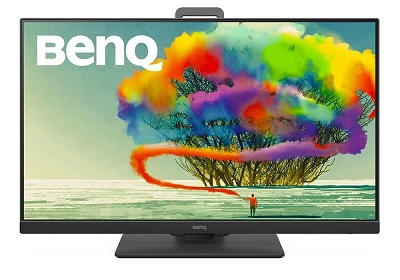
Features and aesthetics
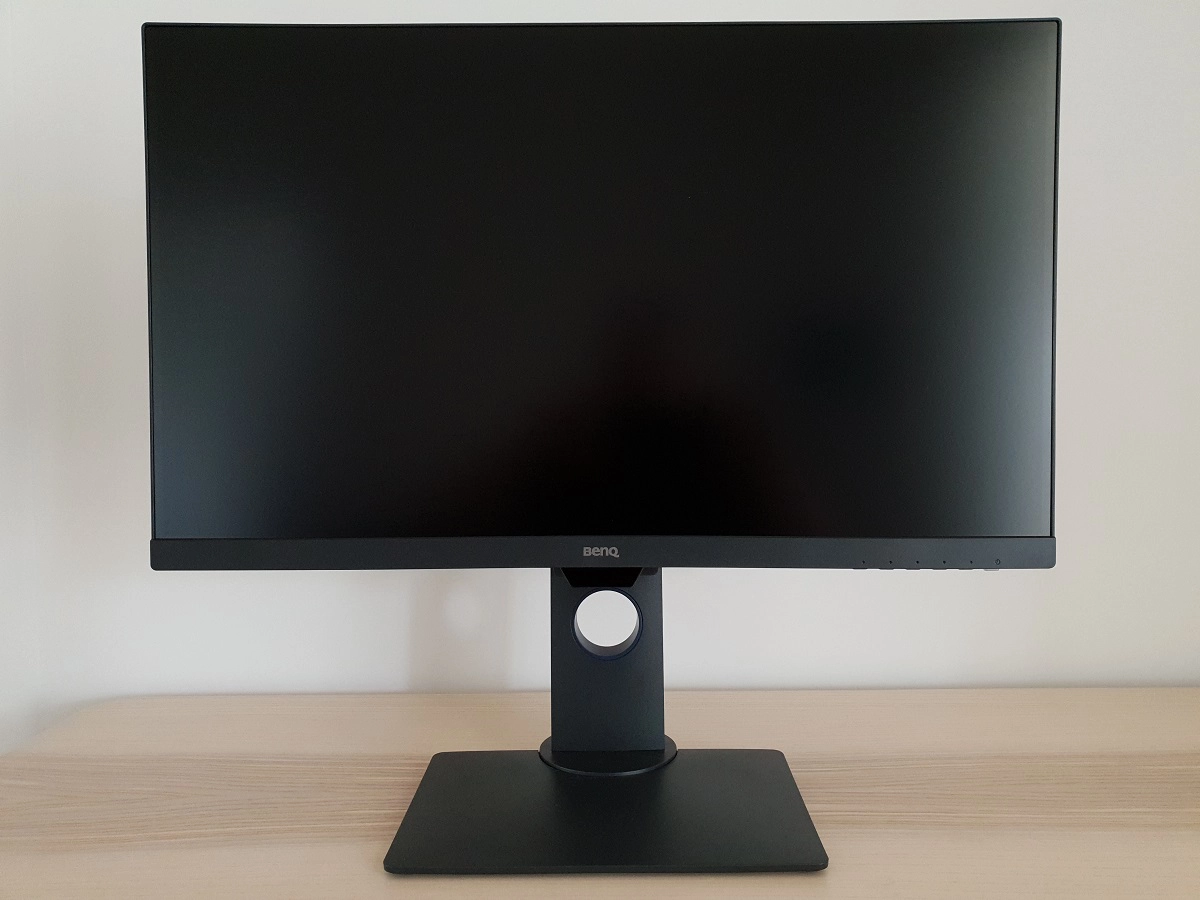
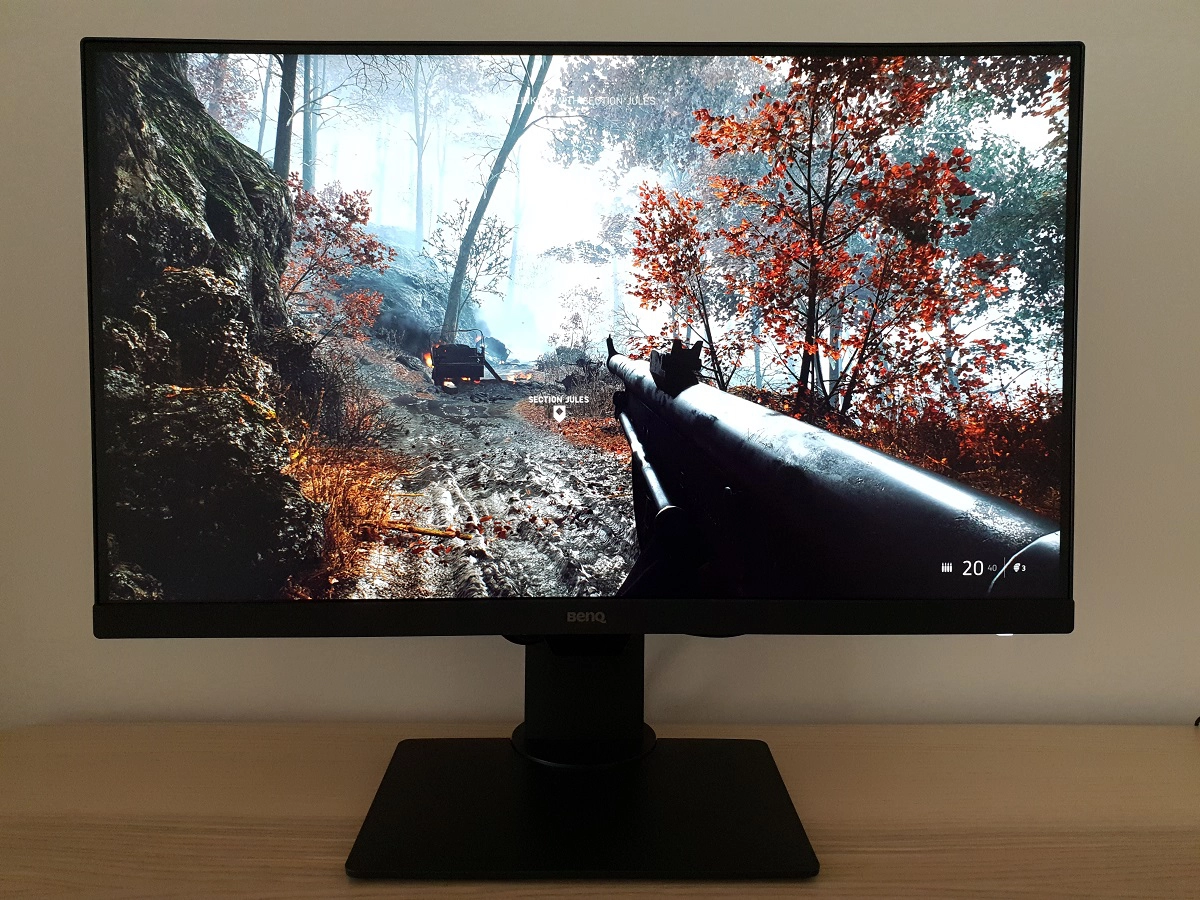
The OSD is controlled by pressable buttons, facing downwards towards the right side of the bottom bezel. There’s a downwards-facing power LED, glowing a gentle and fairly dim cool-white when the monitor is on or amber when the monitor enters a low power state. This system is explored in the video below, alongside BenQ’s ‘DisplayPilot’ software that can used as an alternative way to control the OSD.
From the side the monitor is reasonably slender – ~18mm (0.71 inches) at thinnest point, lumping out centrally. The included stand offers full ergonomic flexibility; tilt (5° forwards, 20° backwards), height (~140mm or 5.5 inches), swivel (45° left, 45° right) and pivot (90° clockwise rotation into portrait). At lowest stand height, the bottom of the screen sits ~30mm (1.18 inches) above of the desk surface, including the central sensor underhang. The top of the screen ~410mm (16.14 inches) above the desk, with the carrying handle at the top of the stand neck poking up an additional ~35mm (1.38 inches). The total depth of the monitor including stand is ~230mm (9.10 inches) with the screen sitting ~55mm (2.17 inches) back from the front edge of the stand. So not a massive desk depth hog by any means.
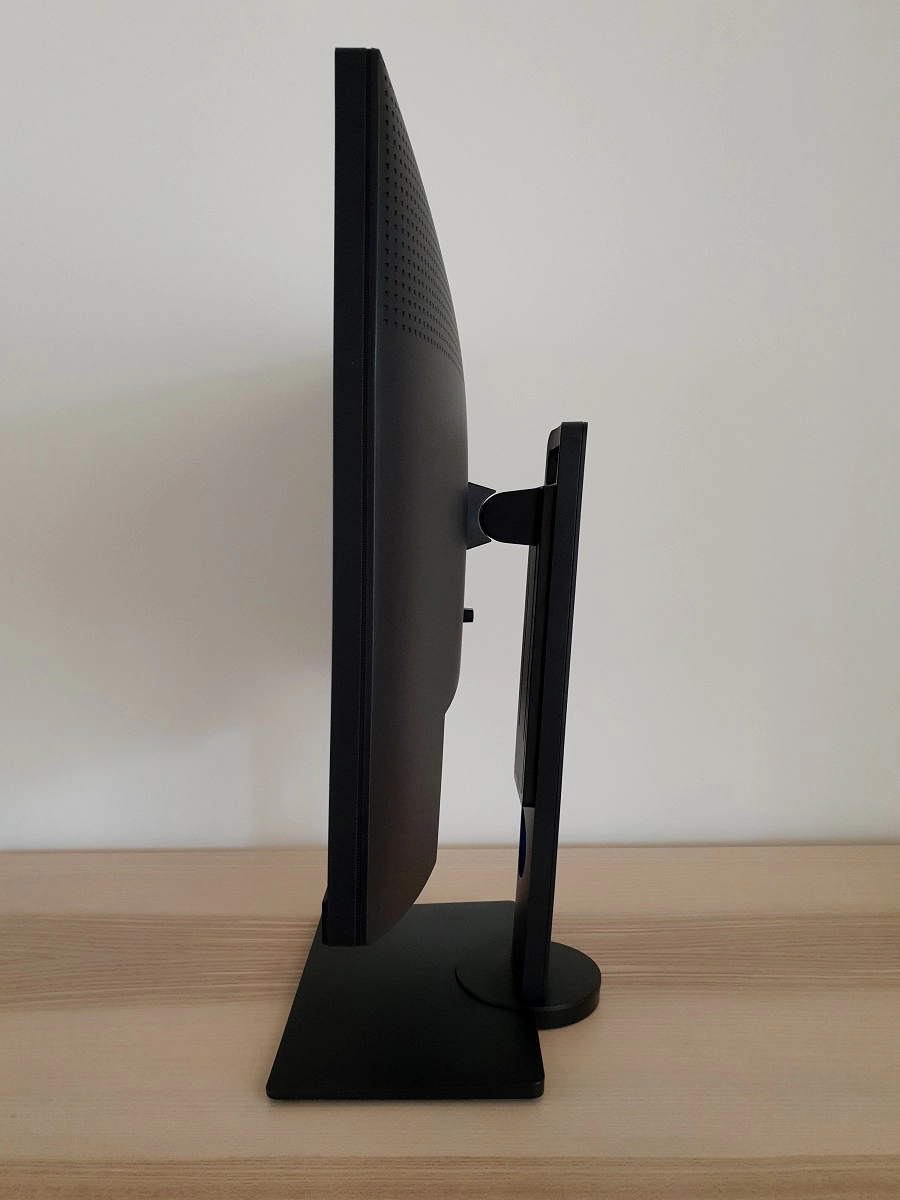
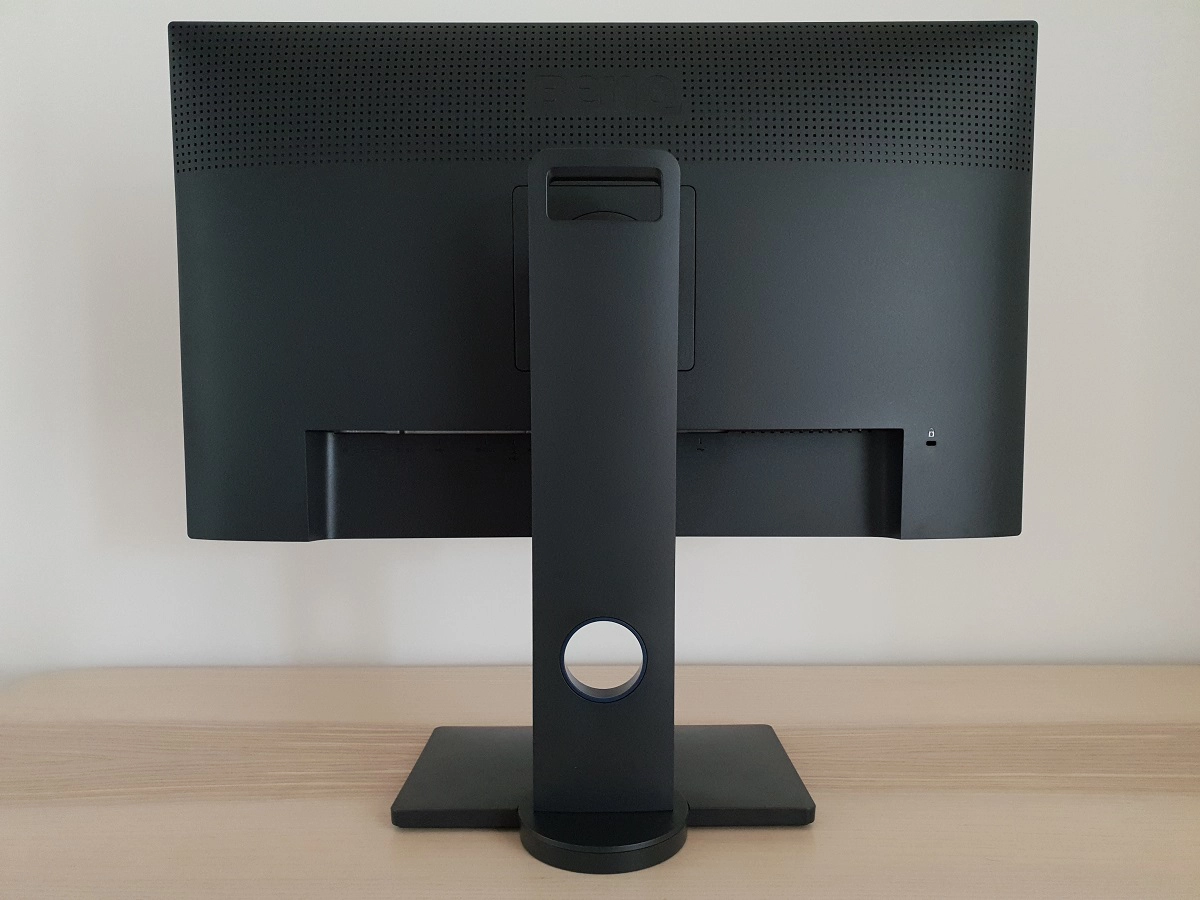
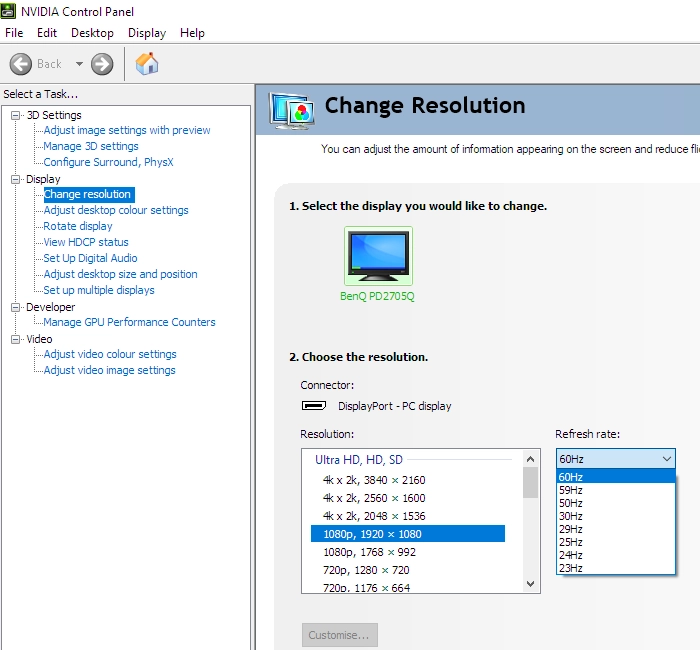
Calibration
Subpixel layout and screen surface
![]()
Testing the presets
Preset Mode Gamma (central average) White point (kelvins) Notes Standard (Factory Defaults) 2.4 6839K A deep and quite vibrant appearance overall, with good variety and strong consistency. A bit too much shade depth in places due to gamma handling and a slightly cool tint due to high colour temperature. Gamma = 1.8 (User) 1.9 6802K As above, but significantly less depth due to much lower gamma and slight green push. Gamma = 2.0 (User) 2.1 6791K As factory defaults with somewhat reduced gamma (and slight green tint). Some shades appear a bit lighter than intended, still a fairly vibrant look to many shades. Gamma = 2.2 (User) 2.4 6874K Similar to factory defaults with very slight green push. Gamma = 2.4 (User) 2.5 6876K As above, slightly higher gamma. Quite a ‘cinematic’ and somewhat ‘contrasty’ look to things. Gamma = 2.6 (User) 2.8 6858K As above with further increase in gamma. Depth of some shades is far too high, a lot of detail where darker shades are involved. Gamma = sRGB (User) 2.4 6879K Similar to ‘Gamma = 2.2’ setting for overall representation, but gamma curve modified to brighten up darker shades (excluding black) slightly. Rec. 709 2.6 6812K An sRGB emulation setting which restricts colour gamut close to sRGB. Image is less saturated and dim due to low default brightness used here (can be adjusted). High gamma makes things appear generally deeper than intended. sRGB 2.4 6880K Similar to Rec. 709 with colour gamut restriction, but brighter by default and gamma somewhat reduced. Low Blue Light = Multimedia 2.4 6286K A weak Low Blue Light (LBL) setting. This offers a slight reduction in blue light output by reducing blue colour channel strength. The image appears warmer than factory defaults. Low Blue Light = Web Surfing 2.4 5763K A slightly stronger LBL setting. The image appears warmer again, with a reduced blue channel. The red channel is relatively strong and green channel weakened slightly – this maintains better balance to the image compared to some LBL implementations. Dimmer by default than ‘Multimedia’, brightness can be adjusted. Low Blue Light = Office 2.4 5197K An effective LBL setting, warmer again in appearance. Dimmer by default than ‘Web Surfing’, brightness can be adjusted. Low Blue Light = Reading 2.4 4812K A very effective LBL setting. Image appears warm (eyes adjust to an extent over time), with strong red channel, slightly reduced green channel and significantly reduced blue channel. Dimmer by default than ‘Office’, brightness can be adjusted. Color Temperature = 5000K (User) 2.4 5185K Quite similar to the ‘Office’ setting in terms of white point, blue channel marginally stronger and brighter by default. Color Temperature = User Define (User) 2.3 6922K Similar to ‘Gamma = 2.2’, with a slightly stronger green tint introduced and slight reduction in average gamma. Test Settings 2.3 6487K A fairly vibrant and varied look overall, some extra depth in places due to gamma handling but nothing extreme.
By no means a poor ‘out of the box’ setup. But for a monitor that claims to be factory calibrated and from a manufacturer that generally hits the spot with gamma calibration (even on some of their ‘entertainment’ series monitors), we were left a bit bemused here. A factory calibration report is included with each unit, although we didn’t have this to hand at time of review. The gamma consistently missed the intended value in the OSD, with the target ‘2.2’ value something that couldn’t be achieved with any setting tested. Nor with reasonable adjustments elsewhere in the OSD. Following the adjustments made to our ‘Test Settings’, gamma was slightly higher than target on average with some sections of the curve hitting the ‘2.2’ target well but others overshooting it. These aren’t extreme deviations by any means, but would still need to be accounted for with colour-critical use in mind. The gamma curve under our ‘Test Settings’ is shown below. Due to inter-unit variation and reasonable performance for our uses following OSD tweaking alone we will not be using any ICC profiles for this review or including any measurements or graphs using them. We wouldn’t recommend using them unless created for your specific unit using your own calibration device. But we appreciate some users still like to use profiles and some aspects such as gamut mapping for colour-aware applications can be useful. You can download our ICC profile for this model, which was created using our ‘Test Settings’ as a base. You can also download our sRGB mode profile which was created using the ‘sRGB’ preset (sRGB emulation mode) of the monitor and corrected gamma from ‘2.4’ to ‘2.2’ on our unit. Note again that these ICC profiles are not used in the review. The monitor also included a range of Low Blue Light (LBL) settings, which as usual for BenQ’s implementation were easy to activate and deactivate. The ‘Reading’ setting was particularly effective in reducing blue light output from the monitor – the effectiveness of any of the settings can be enhanced by also lowering brightness. In all cases this can be manually adjusted. As usual, BenQ doesn’t simply reduce the blue colour channel like some manufacturers would do for their LBL setting. The red channel is also raised and green channel reduced somewhat to help provide a better balance to the image. This comes at the expense of contrast, as explored shortly. Reducing blue light exposure is particularly important in the hours leading up to sleep as blue light is stimulating to the body and affects sleep hormones. It increases alertness and makes it more difficult to ‘shut off’. We used the ‘Reading’ setting for our own viewing comfort in the evenings, but didn’t use it for any specific testing beyond that involving this specific setting. The monitor provided a reasonable balance out of the box. We reduced brightness and made some adjustments to colour channels using the ‘User’ colour setting. It’s important to remember that individual preferences vary and that different units of the same model will require different adjustments. These settings are simply a suggestion and won’t be optimal in all cases. Assume that any setting not mentioned here was left at default in the OSD, including ‘Gamma’. We’ve also included our preferred ‘AMA’ setting, just for reference. HDR has separate settings associated with it (is far more restrictive) and is explored in the relevant section of the review. Brightness= 36 (according to preferences and lighting) Color Temperature = User Define R= 100 Green= 98 Blue= 95 AMA= High We used an X-Rite i1Display Pro to measure white and black luminance levels, from which static contrast ratios could be calculated. The table below shows this data, with various settings used. Assume any setting not mentioned was left at default, except for the changes already noted in the calibration section. Black highlights indicate the highest white luminance, lowest black luminance and maximum contrast ratio recorded under SDR. Blue highlights indicate the results with HDR active and under our ‘Test Settings’.
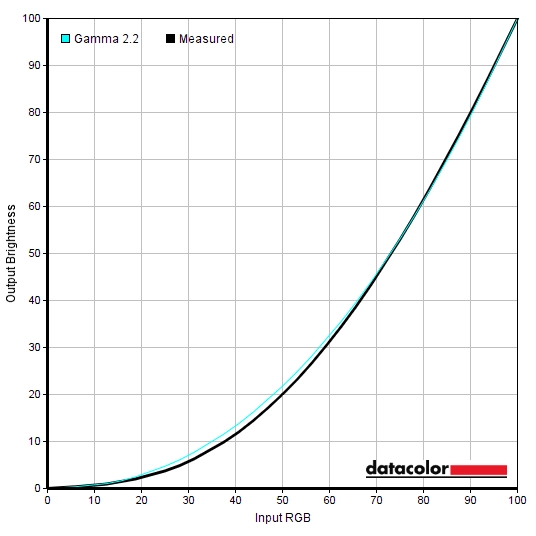
Gamma 'Test Settings'
Test Settings
Picture Mode = User
Contrast and brightness
Contrast ratios
Monitor Settings White luminance (cd/m²) Black luminance (cd/m²) Contrast ratio (x:1) 100% brightness 334 0.31 1064 80% brightness 281 0.26 1081 60% brightness 226 0.21 1076 40% brightness 172 0.16 1075 20% brightness 115 0.11 1045 0% brightness 56 0.05 1120 74% brightness (Factory Defaults) 266 0.25 1064 HDR* 339 0.31 1094 Gamma = 1.8 (User) 269 0.25 1076 Gamma = 2.0 (User) 269 0.25 1076 Gamma = 2.2 (User) 268 0.25 1072 Gamma = 2.4 (User) 266 0.25 1064 Gamma = 2.6 (User) 268 0.25 1072 Gamma = sRGB (User) 267 0.25 1068 Rec. 709 86 0.08 1075 sRGB 268 0.25 1072 Low Blue Light = Multimedia 217 0.26 835 Low Blue Light = Web Surfing 185 0.24 771 Low Blue Light = Office 160 0.21 762 Low Blue Light = Reading 138 0.19 726 Color Temperature = 5000K (User) 230 0.25 920 Color Temperature = User Define (User) 285 0.25 1140 Color Temperature = User Define (User, 100% brightness) 359 0.31 1158 Test Settings 165 0.15 1100
*HDR measurements were made using this YouTube HDR brightness test video, running full screen at ‘1440p HDR’ on Google Chrome. The maximum reading from the smallest patch size (measurement area) that comfortably covered the entire sensor area and colorimeter housing was used for the white luminance measurement, which was ‘4% of all pixels’ in this case. The black luminance was taken at the same point of the video with the colorimeter offset to the side of the white test patch, equidistant between the test patch and edge of the monitor bezel.
The average contrast ratio with only brightness adjusted was 1077:1, just a touch above the specified 1000:1. The highest contrast ratio recorded under SDR was 1158:1, with ‘Color Temperature = User Define’. This sets all colour channels into their neutral position for optimal contrast. Under our ‘Test Settings’ we measured a static contrast of 1100:1, which is quite pleasing for the panel. The lowest contrast values recorded were using the ‘Low Blue Light’ settings, with between 726:1 (‘Reading’) and 835:1 (‘Multimedia’) recorded. This reduction goes hand in hand with the significant colour channel rebalancing that occurs under these settings, designed to optimise image balance as well as significantly reduce blue light output. At the expense of contrast. The highest white luminance recorded was 359 cd/m², whilst the minimum recorded was 56 cd/m². This provides a luminance adjustment range of 303 cd/m², with a fairly but not exceptionally low minimum.
The monitor offers no local dimming and therefore confers no contrast advantage under HDR. The backlight will dim and brighten on its own according to the overall levels of light and dark on the scene. Like a carefully controlled Dynamic Contrast setting which can also use HDR metadata to aid its adjustments. It does this as a single unit, so can’t account for the intricate mixtures of light and dark shades present in most scenes. The values recorded were all in-line with our readings under SDR at a high brightness setting. The white luminance level of 339 cd/m² is not overly bright by HDR standards, whilst the recorded static contrast of 1094:1 is far from spectacular or ‘HDR-like’ as well. Although not documented on the table, an entire white screen fill didn’t yield a significantly higher luminance level either.
PWM (Pulse Width Modulation)
The PD2705Q does not use PWM (Pulse Width Modulation) to regulate backlight brightness at any level and instead uses DC (Direct Current). The monitor is therefore considered ‘flicker-free’, which will come as welcome news to those sensitive to flickering or worried about side-effects from PWM usage.
Luminance uniformity
Whilst observing a black background in a dark room, using our ‘Test Settings’, we noticed some backlight bleed and clouding, particularly towards the top left of the screen. It’s important to note that individual units vary when it comes to backlight bleed and clouding. The image below shows the results on our units, taken a sufficient distance back to eliminate ‘IPS glow’. This is most noticeable towards the bottom corners of the screen, from a normal viewing position. It appears as a bluish silver haze towards the bottom left and a warm and slightly orange haze towards the bottom right. It ‘blooms out’ from sharper viewing angles with hue depending on the angle, as demonstrated in the viewing angles video later on. The luminance uniformity was good. The brightest point recorded was ‘quadrant 1’ towards the top left of the screen (164.9 cd/m²). The greatest deviation from this occurred at ‘quadrant 9’, towards bottom right (149.3 cd/m², which is 9% dimmer). The average deviation between each quadrant and the brightest point was 7.38%, which is good. It’s important to remember that uniformity varies between individual units and you can also expect variation beyond the points measured. The contour maps below show these deviations graphically, with darker greys representing lower luminance and hence greater deviation from the brightest recorded point than lighter greys. Percentage deviations between each quadrant and the brightest point are also given. The SpyderX Elite was also used to analyse variation in the colour temperature (white point) for the same 9 quadrants. The deviation between each quadrant and the quadrant closest to the 6500K (D65) daylight white point target was analysed and a DeltaE value assigned. A DeltaE >3 represents significant deviation that most users could readily notice by eye. The colour temperature uniformity was good overall, with no significant deviation recorded. The point closest to 6500K was measured to the right of centre, with the maximum deviation from this recorded towards the top and bottom left (DeltaE 2.8). It’s again important to remember that individual unit vary when it comes to uniformity and that deviation beyond the measured points should be expected. The monitor provided a reasonable contrast experience on Battlefield V. The static contrast certainly wasn’t high enough to deliver an excellent ‘dark atmosphere’ to darker scenes, such as dimly lit building interiors. There wasn’t a deep and inky look to darker shades, particularly if sitting in a dimly lit room. In addition, there was a moderate amount of ‘IPS glow’, which ate away at detail and atmosphere. Particularly towards the bottom corners of the screen from a normal viewing position, with a cool-silver cast towards the left and warm orange cast towards the right. This was at a typical level for a screen of this size, although the orange cast was somewhat richer in hue than on some IPS-type models due to the phosphors used on the backlight. The gamma consistency was strong, meaning that detail levels were maintained well throughout the screen (aside from some loss of detail due to ‘IPS glow’). There weren’t the sort of shifts you’d see on VA and moreover TN models, where some regions of the screen show excessive detail, introducing a banded or ‘blocky’ appearance’. And others appear clearly too masked and blended. Brighter elements stood out pretty well against darker surroundings, whilst the screen surface imparted a ‘misty’ graininess to such elements rather than giving a ‘smeary’ or layered appearance. Shadow of the Tomb Raider craves a strong contrast performance, with plenty of dimly lit caves, passageways, building interiors and suchlike. The monitor again provided a reasonable contrast performance, typical for an IPS-type panel, but nothing more. Certainly not a deep and atmospheric look to these dark-dominated scenes. The ‘IPS glow’ was again a feature, with quite a disparity in tone between the left and right side of the screen. This isn’t clear in a well-lit room, but in a moderately dim to dim room is certainly noticeable. It becomes more noticeable if you sit closer to the screen, crank up the brightness or have a unit with significant backlight bleed or clouding issues. The strong gamma consistency certainly went in this model’s favour, though, with some quite subtle details such as dimples and pores in rocks visible throughout the screen rather than becoming heavily masked in some areas whilst far too obvious in others. Brighter elements such as fires and bright sunlight breaking through cave openings contrasted well with the darker surroundings. With a light misty graininess rather than anything more obtrusive. We also observed the film Star Wars: The Last Jedi. Like Shadow of the Tomb Raider, this title has plenty of ‘contrasty’ scenes with predominantly dark backdrops lit up by some intense sources of light. The film didn’t look all that cinematic and atmospheric, especially in a dark room. Although we’ve certainly seen worse in that respect, as the static contrast was at least decent rather than poor on this model. The ‘IPS glow’ was visible, more so in a dimly lit room, and again had a clear disparity in tone when comparing the right to left side of the screen. Bright elements still stood out fairly well against darker surroundings and there was no obvious ‘smeary’ graininess from the screen surface. The gamma consistency was again strong. This kept detail levels fairly consistent for dark scenes throughout the screen, save for the areas more strongly affected by ‘IPS glow’. Such as the bottom corners, from a normal viewing position. This strong gamma consistency is more important for heavily compressed streamed content, such as Netflix and YouTube. Where so-called compression artifacts can be brought out in an overly obvious way. This is particularly obvious towards the bottom of TN panels and towards the flanks and bottom of some VA models. Or elsewhere on monitors of any panel type, if the gamma is far too low. On this model such elements were suitably masked and didn’t stand out more than they should. The Lagom tests for contrast allow specific weaknesses in contrast performance to be identified. The following observations were made. The BenQ PD2705Q’s colour gamut (red triangle) was compared with the sRGB reference colour space (green triangle) using our ‘Test Settings’, as shown below. The gamut fully covers sRGB, with some extension beyond towards the red corner in particular. Although not shown in the graphic, we measured 85% DCI-P3 and 78% Adobe RGB coverage. The gamut is therefore some way short of the DCI-P3 target for HDR content, whilst the monitor is unable to accurately display some of the more saturated shades within the DCI-P3 or Adobe RGB colour space (particularly in the green region). The gamut gives the monitor the potential to output all shades within the sRGB colour space, with some extra saturation and vibrancy. On Battlefield V the monitor presented shades in quite a vibrant way, with excellent variety and a richness maintained well throughout the screen. As is the case with most SDR content, the game is designed with the sRGB colour space in mind. So playing the game on a monitor with a wider gamut than this leads to extra vibrancy and saturation. This is very different to the effect a digital saturation boost (such as increasing ‘Saturation’ in the OSD or using Nvidia’s ‘Digital Vibrance Control’) gives. That will pull shades closer to the edge of the gamut without expanding the gamut itself, crushing shades together, negatively impacting shade variety and not making the most saturated shades anymore saturated. Excellent shade variety was maintained, with a particularly vibrant look to some red-biased elements. Fires, for example, were particularly eye-catching with vivid oranges, yellows and reds. Some of the orange shades appeared too deep and verged on red, with yellows tending towards orange – but a varied palette of these shades was still maintained. Some woody tones and earthy textures had a red hue that was brought out too strongly due to the colour gamut, but not to the extent we’ve seen on some models. Vegetation was displayed in quite an impressive way overall, with some particularly lush-looking deep greens displayed alongside suitable pastel shades. Sometimes vegetation can take on an overly ‘neon’ appearance with yellow hues brought out too strongly, but that wasn’t readily observed here. No doubt because the colour gamut doesn’t extend massively beyond sRGB in the green regions. The sky blues looked more muted and less strongly saturated (i.e. more appropriate) than we’ve seen on some models, again due to the colour gamut being more restricted here. Shadow of the Tomb Raider was displayed in a similar way. The greens of vegetation within the environment appeared in-place overall, with a natural look. The deep greens were somewhat stronger than they would appear under sRGB, which we felt was quite fitting. Whilst the more muted shades and dusty greens appeared comparatively muted, as they should, without an overbearing yellow tint or overdone appearance. Lara Croft’s skin appeared somewhat more saturated than intended, but not heavily tanned or sunburnt as models with a wider gamut may show. Licks of red and orange paint, golden shades and roaring flames appeared particularly vivid and quite eye-catching. With more saturation than intended and yellows verging on orange – but a suitable variety of shades to avoid an obvious ‘cartoonish’ appearance. The richness of these shades, and shades more generally, was maintained very nicely throughout the screen due to the strong colour consistency. There weren’t the sort of saturation losses or perceived gamma shifts you’d observe on TN or VA models, where a given shade displayed in one region of the screen may appear quite different to the same shade displayed elsewhere. This idea of strong colour consistency was further reinforced by our observations on the animated TV series Futurama. With large areas of the screen filled by individual shades, this is a particularly effective and unforgiving test for colour consistency. In this respect the monitor performed very well, with a varied look to the image and the colour gamut again coming into play for an extra dose of vibrancy. There were some impressive vibrant elements, such as some rather eye-catching neon pinks and purples. The deep red of Fry (one of main character)’s jumper and orange of his hair appeared strong and certainly deep, if a somewhat more vibrant shade than intended in both cases. There was excellent subtle shade variety, with the skin tones of different characters appearing distinct and maintaining their distinct look throughout the screen. Even if they appear a touch more saturated than they should in some cases. Such subtleties are lost on VA and TN models, where saturation levels change depending on where on the screen the shade is displayed. Such shifts can be particularly noticeable for the red lobster-like creature Dr Zoidberg (TN example), but consistency was excellent in this case. The image below shows a printed reference sheet of 24 ‘sRGB’ shades, included as part of the Datacolor SpyderCHECKR 24 package. The screen is displaying reference photographs of this printed sheet, in both the same order as printed (right side) and reverse order (left side). The camera is mounted slightly above centre so that the image is representative of what the eye sees from an ergonomically correct viewing position. This, coupled with the inclusion of a flipped version of the shade sheet, allows both accuracy and colour consistency to be visually assessed. Bracketed numbers in our analysis refer to shades on the printed sheet or right side of the screen if they’re ordered consecutively from top left to bottom right. Note that there is always some disparity between how emissive objects (monitor) and non-emissive objects (printed sheet) appear. The representation of shades in this image depends on the camera and your own screen, it’s not designed to show exactly how the shades appear in person. It still helps demonstrate some of the relative differences between the original intended sRGB shade and what the monitor outputs, however. Full profiling and appropriate colour management on the application would provide a tighter match, our intention here is to show what can be expected in a non colour-managed environment. Lagom’s viewing angle tests help explore the idea of colour consistency and viewing angle performance. The following observations were made from a normal viewing position, eyes ~70cm from the screen. On some monitors, particularly but not exclusively those with high refresh rates, interlace patterns can be seen during certain transitions. We refer to these as ‘interlace pattern artifacts’ but some users refer to them as ‘inversion artifacts’ and others as ‘scan lines’. They may appear as an interference pattern, mesh or interlaced lines which break up a given shade into a darker and lighter version of what is intended. They often catch the eye due to their dynamic nature, on models where they manifest themselves in this way. Alternatively, static interlace patterns may be seen with some shades appearing as faint horizontal or vertical bands of a slightly lighter and slightly darker version of the intended shade. We did not observe obvious examples of either artifact type on this monitor. We could observe a very faint polygonal mesh when very closely observing movement, for some shades. But this was very faint and not at all eye-catching to us. Certainly too slight for most users to notice. A small utility called SMTT 2.0 was used alongside a sensitive camera to analyse the latency of the PD2705Q, with over 30 repeat readings taken to help maximise accuracy. Using this method, we calculated 4.90ms (under 1/3rd of a frame at 60Hz) of input lag. This value reflects both the element you ‘see’ (pixel responsiveness) and the element you ‘feel’ (signal delay). It indicates a fairly low signal delay which most users should be just fine with. Note that we don’t have the means to accurately measure input lag with HDR active in an HDR environment. Our article on responsiveness explores the key aspects of monitor responsiveness. Chief amongst these is the concept of ‘perceived blur’, which is contributed to by both the movement of your eyes as you track motion on the screen and the pixel responses of the monitor. The first element is predominant on a modern monitor, but pixel responses also play an important role. The responsiveness article also covers a photography technique referred to as ‘pursuit photography’. This uses a moving rather than stationary camera to capture motion in a way that reflects both elements of perceived blur. This contrasts with the use of a stationary camera, capturing motion in a way that only reflects pixel responsiveness. The images below are pursuit photographs taken using the UFO Motion Test for ghosting, with the test running at 960 pixels per second. This is a good practical speed for capturing such photographs and highlights both elements of perceived blur nicely. The UFOs move across the screen from left to right at a frame rate matching the refresh rate of the display, which is 60Hz (60fps) in this case. All background shade levels (dark, medium and light) were used with the monitor set to various ‘AMA’ (Advanced Motion Acceleration) pixel overdrive settings; ‘OFF’, ‘High’ and ‘Premium’. The final column shows a reference display, set to what we consider its optimal pixel overdrive setting and running at the same 60Hz refresh rate. The AOC AG273QCG, a fast and well-tuned TN model that shows how things look where pixel responses aren’t really a limiting factor. The UFOs appear quite broad, softly focused without sharp internal detailing. This reflects a moderate degree of perceived blur due to eye movement and is a characteristic shared with the reference display. There is also some trailing behind the object due to weaknesses in pixel responsiveness. This is strongest with ‘AMA = OFF’, but cut down quite effectively with the ‘AMA = High’ setting. Some ‘powdery’ trailing still remains, particularly for the dark background (top row). The medium background (middle row) shows a lighter dusting of this ‘powdery’ trailing, whilst the light background (bottom row) shows very little. ‘AMA = Premium’ ramps up the pixel overdrive significantly, eliminating the ‘powdery’ trailing but putting strong overshoot (inverse ghosting) in its place. There is obvious bright and colourful ‘halo’ trailing behind the UFOs. The reference screen by comparison is free from both the ‘powdery’ trailing and strong overshoot, with just a little overshoot behind the UFOs. From this assessment we consider ‘AMA = High’ to be optimal. On Battlefield V there was a moderate degree of perceived blur. This was largely related to eye movement and linked to the 60Hz refresh rate. There were some weaknesses on top of this related to pixel responses, but nothing major. There were some instances of ‘powdery trailing’, similar to what was demonstrated using the UFO Motion Test for ghosting earlier. This was most pronounced where darker objects moved against somewhat lighter shades in the background, such as a dark tree trunk against a dusk sky. This created what we’d describe as a ‘heavy’ powdery trailing, but it wasn’t what we’d describe as ‘smeary’ and in that respect was different to weaknesses you’d typically see on VA models for such transitions. The trailing stuck closer to the object and was shorter-lived in comparison. We also observed some overshoot in the form of ‘halo’ trailing, but nothing that stuck out too much. This generally occurred where medium-dark shades moved against lighter shades, creating trailing that was slightly lighter than the background shade. And sometimes had a touch of colour to it, such as blue. This was quite blended and subdued overshoot rather than anything too eye-catching. We made similar observations on Shadow of the Tomb Raider. With plenty of dark and lighter content inter-twining, there were certainly some instances of ‘powdery’ trailing as well as some overshoot. But nothing we found distracting and nothing that really created massive distance between this model and the most competent 60Hz performers out there. We also observed video content at a range of frame rates. This included ~24 – 30fps content (Netflix, YouTube, Amazon Prime Video etc). Unsurprisingly, the higher frame rate content highlighted similar slight weaknesses to what was observed when gaming at 60fps – so nothing that greatly impeded our enjoyment of the content. There were no real weaknesses for the lower frame rate content, with the frame rate itself being the key barrier to visual fluidity. And indeed, knocking down the pixel response requirements for optimal performance quite considerably. Some slight traces of overshoot in places for a minority of pixel transitions, but this was very well-blended and not at all obvious. As an Amazon Associate and Newegg Affiliate I earn from qualifying purchases made using the below link. Where possible, you’ll be redirected to your nearest store. Further information on supporting our work. On an ideal monitor, HDR (High Dynamic Range) involves the simultaneous display of very deep dark shades and very bright light shades. It also involves the display of an excellent array of shades between these extremes, including very vibrant and saturated shades alongside much more muted shades. Ideally, per-pixel illumination would be used (backlightless technology such as OLED, for example). If not, a very large number of dimming zones controlled with excellent precision – a FALD (Full Array Local Dimming) solution with a very high number of dimming zones, for example. This allows some areas of the screen to display very deep dark shades whilst other areas display brilliant bright shades. Colour reproduction is also an important part of HDR. The longer term goal is support for a huge colour gamut, Rec. 2020. A more achievable near-term goal is support for at least 90% DCI-P3 (Digital Cinema Initiatives standard colour space) coverage. Finally, HDR makes use of at least 10-bit precision per colour channel, so its desirable that the monitor supports at least 10-bits per subpixel. The HDR10 pipeline is the most widely supported HDR standard used in HDR games and movies and the pipeline supported by this model. For most games and other full screen applications that support HDR, the BenQ PD2705Q automatically switches into its HDR operating mode. As of the latest Windows 10 update, relevant HDR settings in Windows are found in ‘Windows HD Color settings’ which can be accessed via ‘Display settings’ (right click the desktop). Most game titles will activate HDR correctly when the appropriate in-game setting is selected. A minority of game titles that support HDR will only run in HDR if the setting is active in Windows as well. Specifically, the toggle which says ‘Play HDR games and apps’. If you want to view HDR movies on a compatible web browser, for example, you’d also need to activate the ‘Stream HDR Video’ setting. These settings are shown below. Also note that there’s a slider that allows you to adjust the overall balance of SDR content if HDR is active in Windows. This is really just a digital brightness slider, so you lose contrast by adjusting it. The balance of the image was a lot better than on some models displaying SDR content with HDR enabled, but the loss of brightness control alone is good reason not to use it unless you need to. We’d recommend only activating HDR in Windows if you’re about to specifically use an HDR application that requires it, and have it deactivated when viewing normal SDR content on the monitor. For simplicity we’ll focus our attention on two PC game titles for this section; Battlefield V and Shadow of the Tomb Raider. We’ve tested these titles on many HDR-capable monitors before and know they offer a good HDR implementation and are therefore an appropriate test for HDR capability. The experience we describe here is largely dictated and limited by the screen itself. Although our testing here is focused on HDR PC gaming using DisplayPort, we made similar observations using HDMI. The observations apply to other HDR content, such as movies, and also running HDR on compatible games consoles. There is very little you can configure when running the monitor under HDR, although you can at least adjust sharpness to your liking (it’s somewhat high by default, as usual under HDR to help accentuate the potential contrast boost and nuanced shade variety). The image has a cool tint as well, much like our unit did under SDR – but you have no control over this in the OSD when running HDR. The monitor only offers very rudimentary HDR support, falling short of even the most basic VESA DisplayHDR standard (VESA DisplayHDR 400). On the plus side, 10-bits per subpixel can be used (8-bit + FRC) which enhances the precision and nuanced shade variety. This benefit was evident on both titles, with an excellent variety of closely matching dark shades helping give shaded areas a more realistic appearance. On Battlefield V, for example, the underside of vehicles showcased a strong variety of dark shades that gave a somewhat more natural and believable look to such shadowy areas. At the high-end, an excellent variety of subtly different brighter shades was presented as well. Weather effects, smoke and certain special effects were displayed with much smoother gradients in many cases, again providing a somewhat more believable look to some scenes. This is really where the HDR capability of the monitor ended, however. Per our earlier measurements, the luminance was very limited by HDR standards (339 cd/m² recorded). And there is no local dimming, so there was no contrast advantage offered here. On the contrast side, things essentially look as they do if you have the backlight set manually to a high level under SDR. There is a Dynamic Contrast element added so it dims slightly for predominantly dark content, but even there there isn’t an impressive depth and atmosphere. And ‘IPS glow’ tends to overwhelm the scene, unless viewing in a rather bright room. For mixed scenes the bright shades didn’t ‘pop’ in an eye-catching way due to the limited luminance levels, whilst the darker elements didn’t appear anywhere near as deep as they should. Something that would further enhance that ‘nuanced shade variety’ we mentioned earlier and complete the more believable look to scenes that HDR can provide. The section of video review below runs through the HDR performance with some specific examples from Shadow of the Tomb Raider. You may want to run the monitor at a lower resolution than the native 2560 x 1440, perhaps for better performance or to use a device such as a games console which doesn’t support native WQHD output. The monitor supports scaling functionality via any of its display inputs. As noted in the features and aesthetics section a range of refresh rates (up to 60Hz) are supported at the Full HD resolution, whilst a ‘4K’ UHD downsampling mode is also offered. To ensure the monitor rather than GPU is handling the scaling process, you need to make sure the GPU driver is set up correctly. For AMD GPU users the monitor will handle the scaling by default, when gaming at non-native resolutions. Nvidia users should open the Nvidia Control Panel and navigate to ‘Display – Adjust desktop size and position’. They should ensure that ‘No Scaling’ is selected and ‘Perform scaling on:’ is set to ‘Display’ as shown below. There are three scaling modes listed under ‘Picture’ – ‘Advanced’ – ‘Display Mode’ in the OSD; ‘Full’, ‘Aspect’ and ‘1:1’. The ‘Full’ setting uses an interpolation process to use all pixels on the screen to display the image. The ‘Aspect’ setting will do the same whilst respecting the aspect ratio of the source resolution (it’s greyed out if a 16:9 resolution is selected). The ‘1:1’ setting is a 1:1 pixel mapping mode which will only use the pixels called for in the source resolution when displaying an image. A black border will be displayed for remaining pixels. The monitor displayed the image under 1920 x 1080 (‘1080p’ Full HD) in a way that was a bit softer than on a native Full HD model of the size. But things didn’t look as soft as we’ve seen on some models when using interpolation to display this resolution. You can also adjust the ‘Sharpness’ setting between ‘1’ and ‘10’ (in single unit increments), in the ‘Picture’ section of the OSD. ‘5’ is the default setting, but we found a slight bump up to ‘7’ worked nicely for a bit of an edge in sharpness. Whilst some elements were slightly over-sharpened, most noticeable on fine text or very thin lines, we felt the overall look was quite good for games. We felt the monitor was very useable for the Full HD resolution when set up in this way and found the overall interpolation performance quite pleasing. As usual, if you’re running the monitor at 2560 x 1440 and viewing 1920 x 1080 content (for example a video over the internet or a Blu-ray, using movie software) then it is the GPU and software that handles the upscaling. That’s got nothing to do with the monitor itself – there is a little bit of softening to the image compared to viewing such content on a native Full HD monitor, but it’s not extreme and shouldn’t bother most users. The video below shows the monitor in action. The camera, processing done and your own screen all affect the output – so it doesn’t accurately represent what you’d see when viewing the monitor in person. It still provides useful visual demonstrations and explanations which help reinforce some of the key points raised in the written piece. The BenQ PD2705Q is designed for the home-office environment, offering a comfortable screen size and resolution for work purposes. As a member of the PD ‘DesignVue Designer Monitor’ series, the marketing is weighted towards colour-critical usage. The screen itself was well-built with a sensible and quite robust design. A light sensor is included as a fairly prominent feature, due to the underhanging sensor unit at the front. However; we felt this so-called ‘Bright Intelligence’ functionality was too rigid. A ‘one size fits all’ approach to brightness adjustment that doesn’t work when everybody’s eyes and brightness sensitivities are different. The full ergonomic flexibility of the stand and range of ports offered was quite agreeable, as was the range of image adjustment options available in the OSD. Despite this flexibility in the OSD and the claimed strong factory calibration, our unit was a bit ‘off’ in terms of its gamma handling. We weren’t able to get it to track the ‘2.2’ curve correctly with any reasonable OSD adjustment and the gamma never quite corresponded to the claimed value in the OSD. That wasn’t to say it was far off, but it’s a bit curious given the claims made by the manufacturer. And the fact we’ve seen better gamma tracking from some of their recent EW and EX series models despite them not promising such a stringent factory calibration. Colours were represented in quite a vibrant way overall, with good variety and strong consistency. The gamut offered a fair bit of extension beyond sRGB in the red region, but was more tame in the green and blue regions. A few effective sRGB emulation settings were provided – and although gamma and colour channel adjustments were locked, brightness was at least accessible. The contrast performance was much as we were expecting. Static contrast was close to the specified 1000:1, a touch beyond using our ‘Test Settings’ in fact. There was moderate ‘IPS glow’, which ate away at detail and atmosphere towards the bottom corners in particular from a normal viewing position. Gamma consistency was excellent, so detail levels were appropriately maintained for dark scenes at different points of the screen. The screen surface was very light matte anti-glare, offering more direct emission of light and allowing the monitor to display an image without an obvious ‘layering’ in front of it. The surface texture wasn’t the smoothest we’ve seen, there was some ‘misty’ graininess to it, but nothing ‘heavy’ or ‘smeary’. The monitor also provided basic HDR10 support. We stress the basic, as the brightness levels were quite limited and there was no local dimming. The atmosphere created for dark scenes was far from impressive under HDR, whilst bright elements didn’t have that standout ‘pop’ that more capable HDR displays can achieve. The 85% DCI-P3 colour gamut coverage was quite limited for HDR10 output, too, without some of the strongly saturated deep greens, blues and purples we’ve seen in some cases. Some of the oversaturation observed for red-biased shades under SDR was effectively curtailed, though. Whilst some vibrant reds and deep oranges were displayed where the developers intended. 10-bit precision was also used, with the help of GPU dithering, enhancing the nuanced shade variety and providing smoother gradients for special effects and suchlike. Responsiveness is certainly not a focus of this monitor, although it performed pretty well as far as 60Hz models go. There were some slight weaknesses in terms of ‘powdery’ trailing as well as some overshoot in places, but nothing extreme or particularly eye-catching. The input lag was fairly low, too, so that didn’t impede the experience. Some manufacturers have moved more towards 75Hz as their lower-end refresh rate for their 2560 x 1440 (WQHD) models. The ASUS PA278QV comes to mind as a model with a similar market position to this but with a 75Hz refresh rate and Adaptive-Sync support. It also promises a strong factory calibration, but we haven’t tested it ourselves and haven’t seen detailed testing on it at this stage so can’t offer a technical comparison. It’s cheaper at time of review than the BenQ and we’ve received some positive user feedback on the ASUS for both work and play. The Dell U2719D is also an interesting model to keep in mind as an example of a monitor that seems consistently well-calibrated from the factory. The BenQ PD2705Q in comparison has a lighter matte screen surface, which we appreciate, as well as a more generous colour gamut – particularly for those red shades. It also offers basic HDR support, greater OSD flexibility (gamma settings) and a more robust design that’s perhaps less prone to uniformity issues. We feel the BenQ is well-suited for users who have their own colorimeter or spectrophotometer and offers quite respectable all-round performance. But we also hope that our unit was something of an exception in terms of its factory gamma calibration, because strong factory calibration is such a focal point for this model. The bottom line; a solidly built monitor with respectable all-round performance – 60Hz limitation, lack of Variable Refresh Rate technology and unreliable factory calibration may sour the experience.
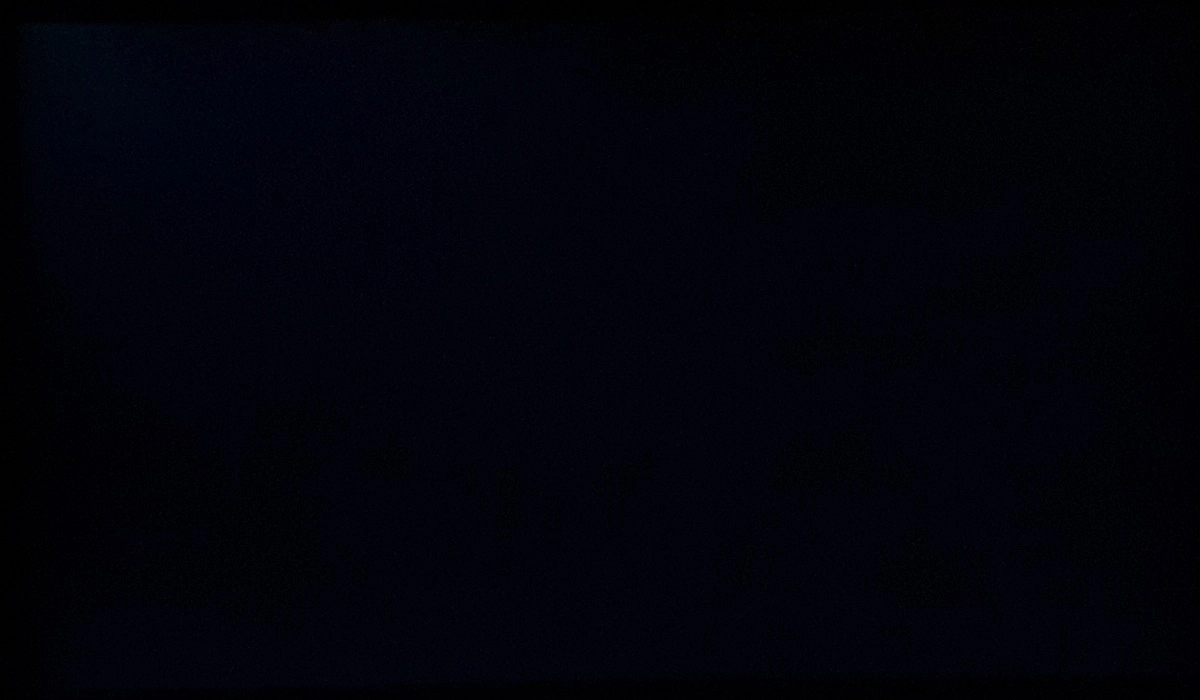
The SpyderX Elite was used to assess the uniformity of lighter shades, represented by 9 equidistant white quadrants. The luminance of each quadrant was measured and compared to the brightest measured quadrant. The table below shows these values as well as the percentage deviation between each quadrant and the brightest point measured.

Luminance uniformity table
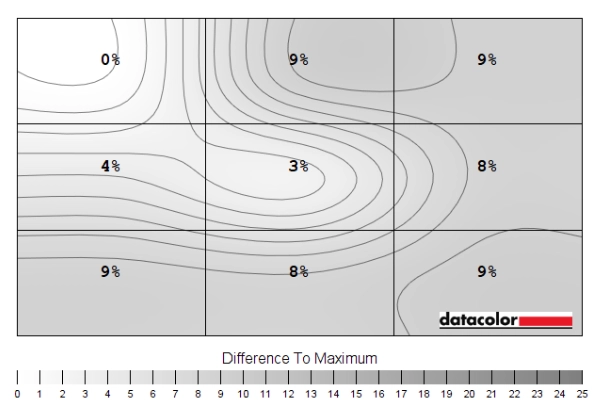
Luminance uniformity map
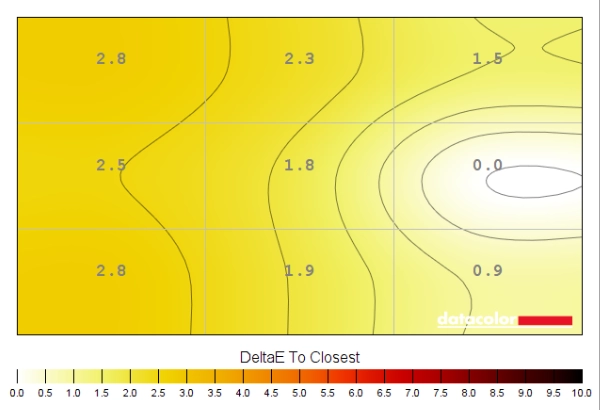
Colour temperature uniformity map
Contrast in games and movies
Lagom contrast tests
Colour reproduction
Colour gamut
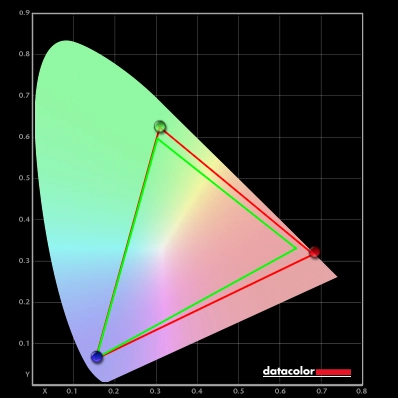
Colour gamut 'Test Settings'
The monitor also offers two sRGB emulation settings – accessible by setting the ‘Picture Mode’ to ‘REC.709’ or ‘sRGB’ in the ‘Picture Advanced’ section of the OSD. The differences between these were covered in the calibration section, but the gamut is very similar as shown below. 100% sRGB coverage is again offered, but there’s now very little extension beyond this. If you’re profiling the monitor and have a colour-managed workflow either the native gamut or an sRGB emulation mode could be used, with 100% sRGB coverage in both cases. With the native gamut you have more flexibility, including access to colour channels and gamma settings on the monitor. Depending on your workflow you may also wish to use the extension beyond sRGB from the native gamut, to broaden your palette so to speak. But be aware of the significant under-coverage of higher gamut standards such as DCI-P3 and Adobe RGB as noted earlier. Indeed, this monitor was only ever marketed as covering ‘100% sRGB’ and the sRGB colour space is really the main target here.
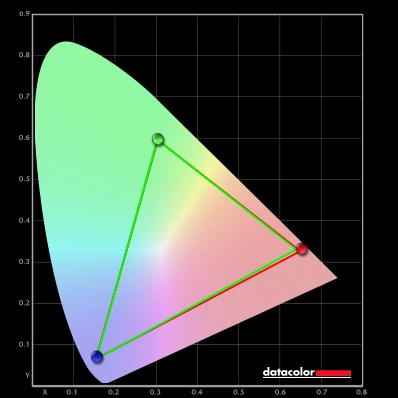
Colour gamut 'Rec.709'
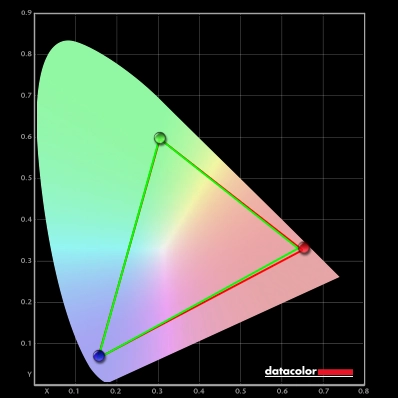
Colour gamut 'sRGB'
Colour in games and movies
Shade representation using SpyderCHECKR 24
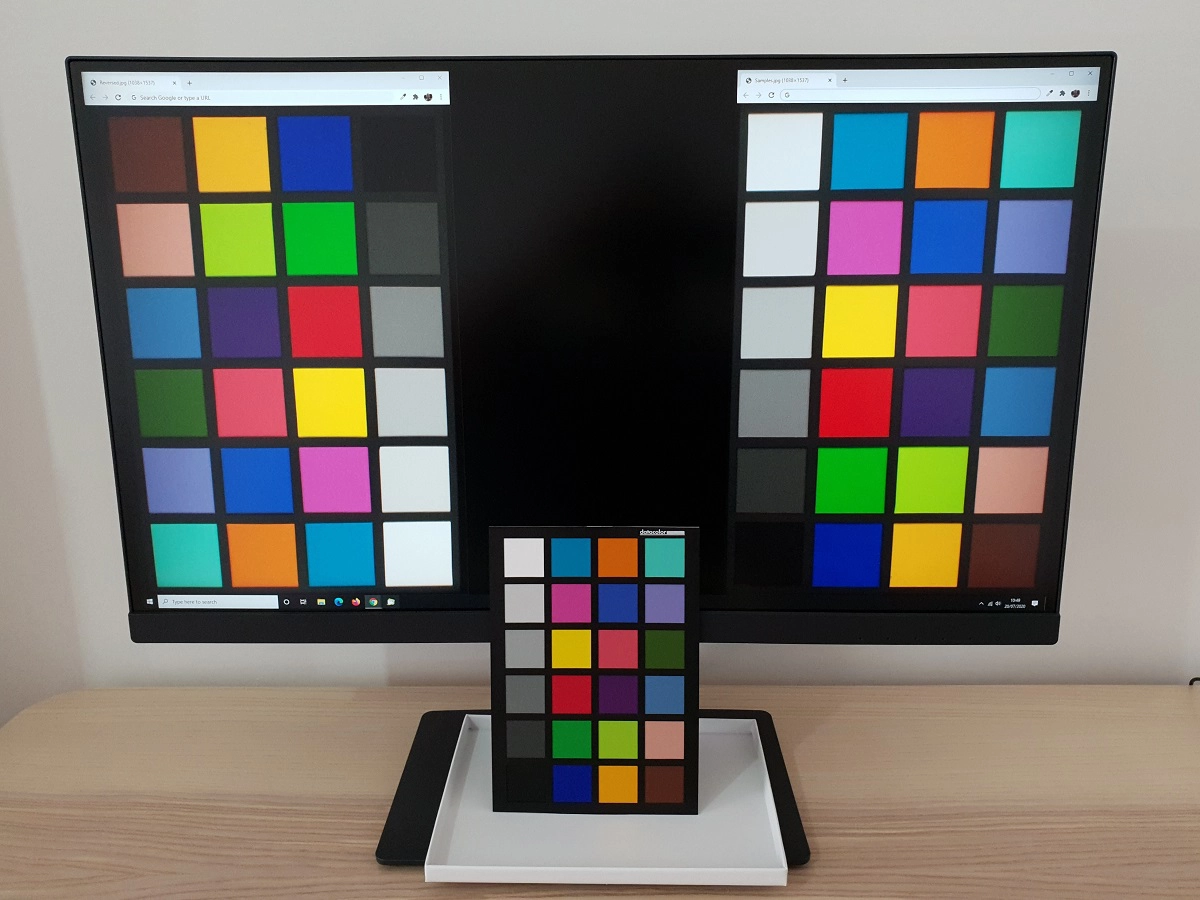
The monitor presents shades quite faithfully overall, with a touch of extra saturation in some cases. Most notably for shades containing a fair degree of red, which makes sense given the extension of the gamut in that region. Persian pink (6) and tango pink (11) look somewhat livelier than intended, more so to the eye than is evident in the picture. Candy apple red (14) appears a touch neon, whilst peach pink (20) and light chocolate brown (24) have slightly too much of a red cast. Dark lime green (18) and yellow green (19) are represented well, especially compared to models with more extension in the green region which would give a neon appearance to such shades. The colour consistency is strong, too, with a given shade appearing similar regardless of on-screen position. There certainly aren’t the sort of shifts that are evident on VA and moreover TN models when comparing the shades in ‘as printed’ (right) vs. reversed (left) order. The image below shows how things appear using the sRGB emulation setting (‘Picture Mode = sRGB’).
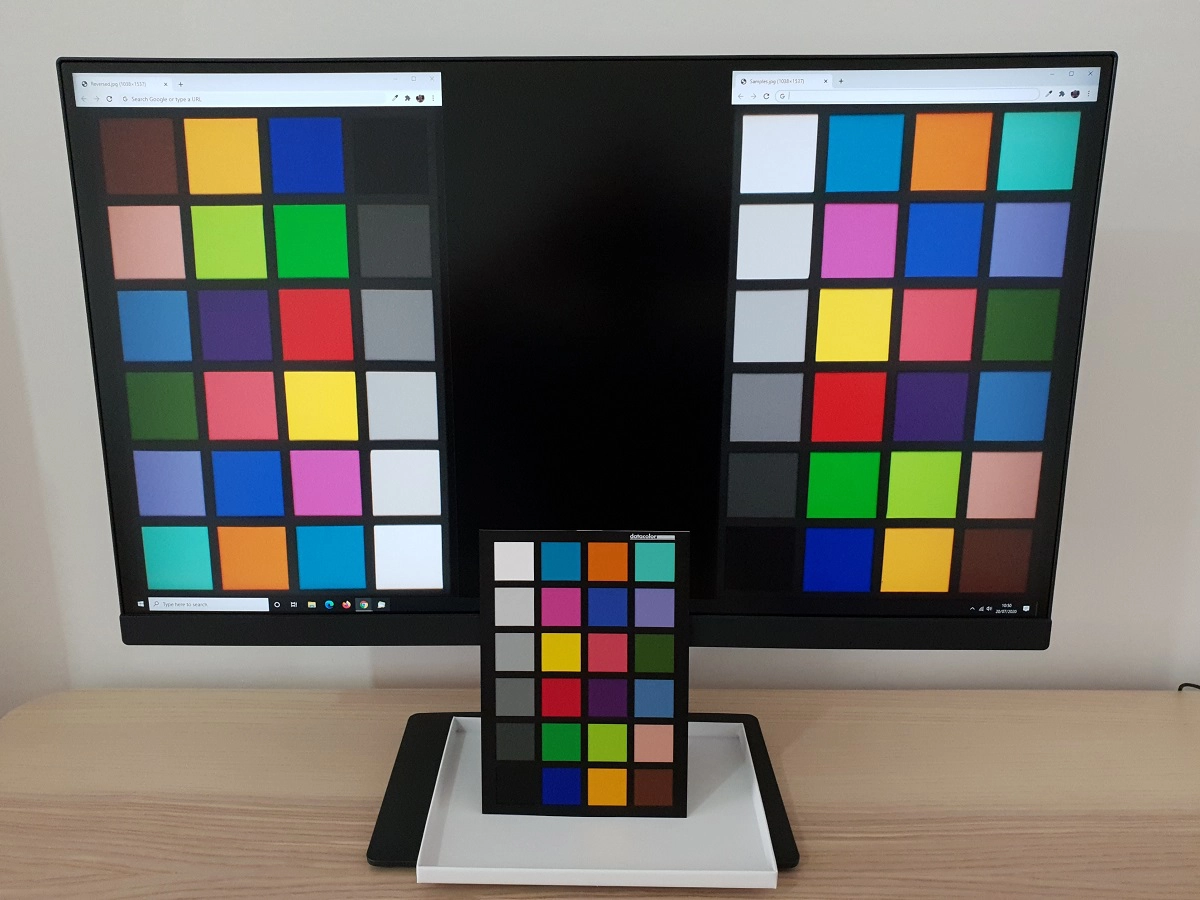
The saturation levels are toned down now, particularly for the red-biased shades that were a bit ‘overdone’ before. Light chocolate brown (24) has a more neutral appearance without overly strong red hue, for example, whilst candy apple red (14) is represented very well without appearing too neon. Some shades appear just slightly undersaturated, although this effect is exaggerated somewhat in the image. Gamboge (23) doesn’t have the rich saffron-like quality to it and verges a bit too much on the yellow vs. orange side. Medium orange (3) appears slightly too pale. But overall, the representation is respectable and consistency is strong. This is despite our unit being far from perfect in terms of its calibration, as noted before. No major issues there, but the gamma being a touch higher than intended and with the sRGB emulation setting the colour temperature just a touch too cool. Profiling the monitor with your own colorimeter or spectrophotometer is always advised for best results if the strongest colour accuracy is desired.
Viewing angles
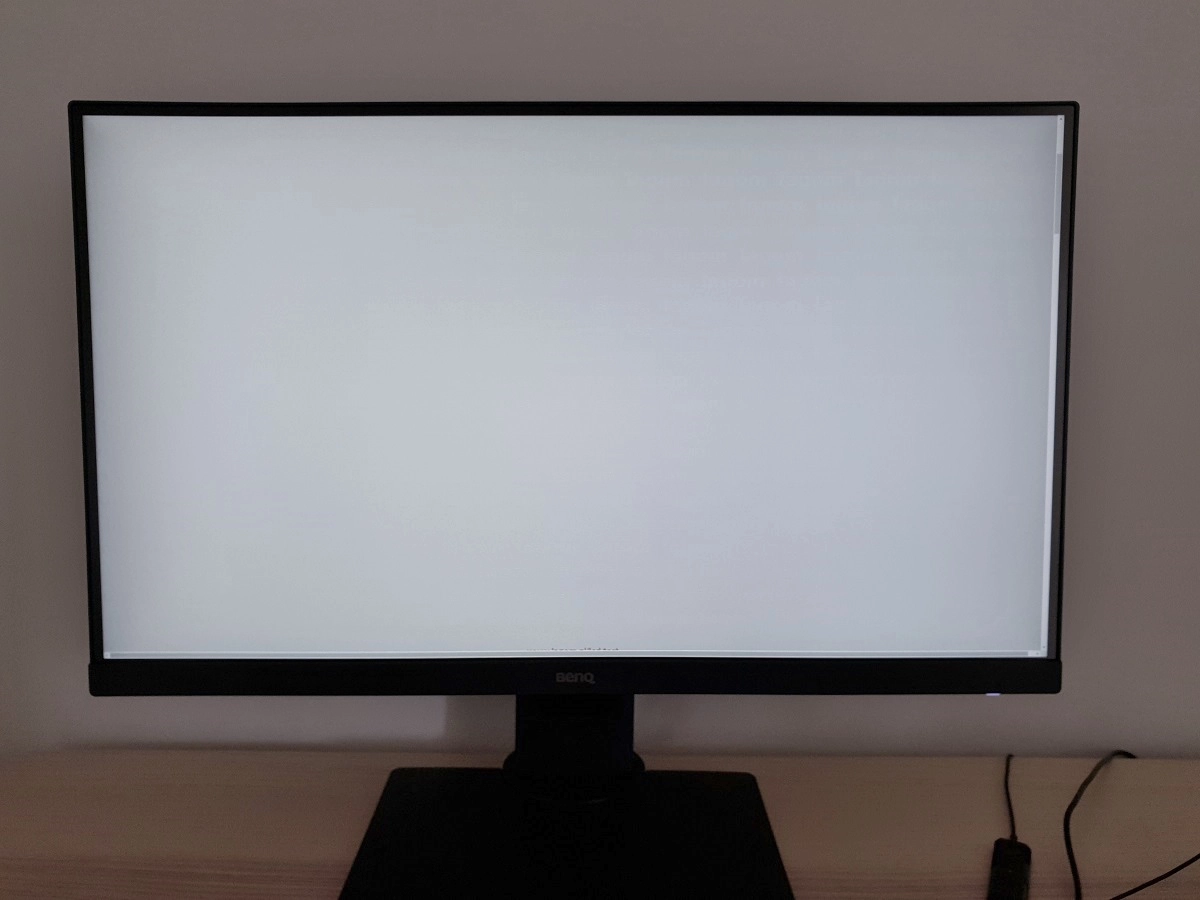
The video below shows the Lagom text test, a mixed desktop background, game scene and dark desktop background from a variety of viewing angles. You can see relatively minor shifts in contrast and colour for the mixed desktop background and game scene. Less pronounced than you’d see on TN or VA models. The dark desktop background highlights ‘IPS glow’, which creates a clear ‘bloom’ as viewing angles steepen. Depending on angle, the glow may take on a cool bluish-silver appearance or warm and slightly orange hue.
Interlace pattern artifacts
Responsiveness
Input lag
Perceived blur (pursuit photography)
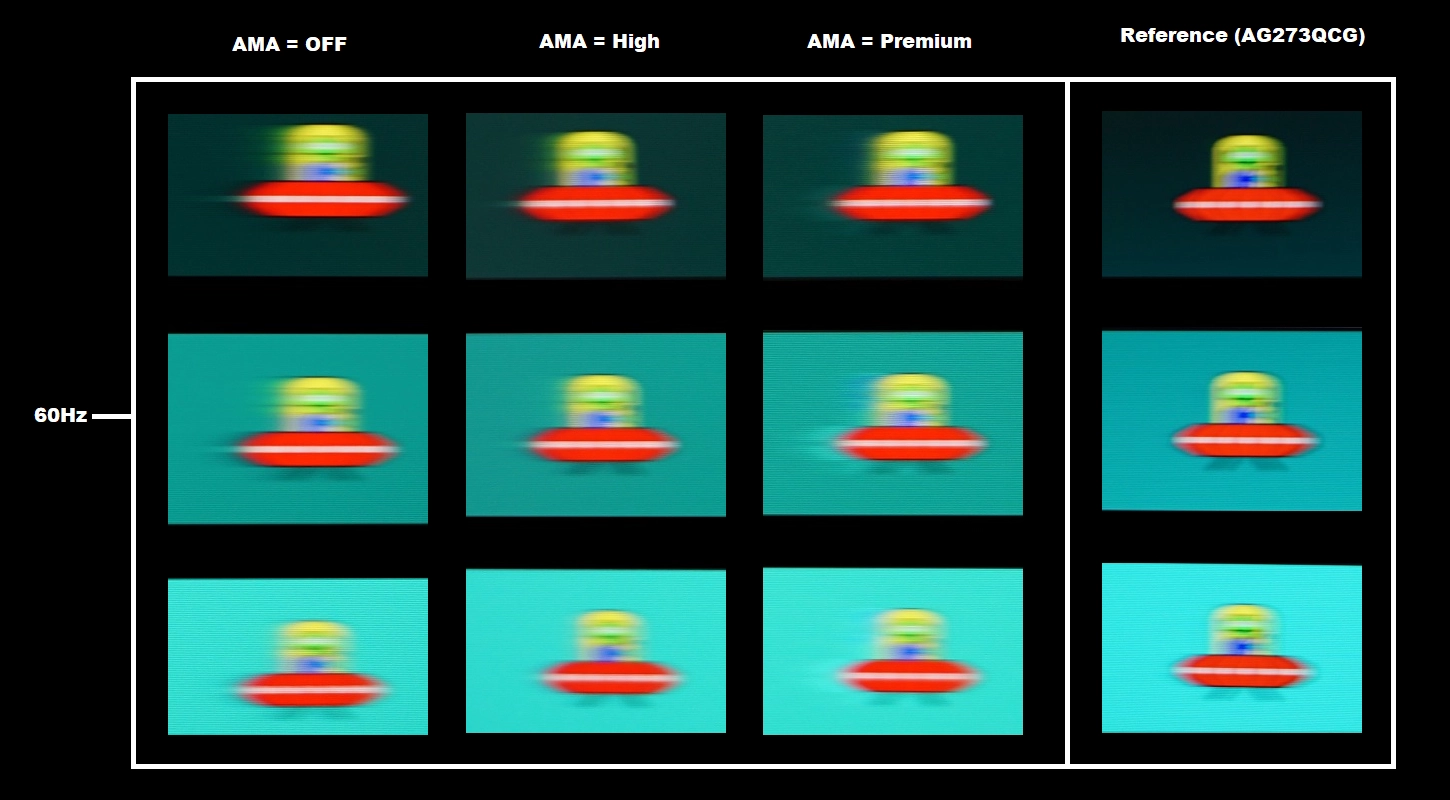
Note that we will not be including a section on overclocking, as the monitor skipped frames if set much above 60Hz at its native resolution or indeed lower resolutions such as Full HD.
Responsiveness in games and movies

HDR (High Dynamic Range)
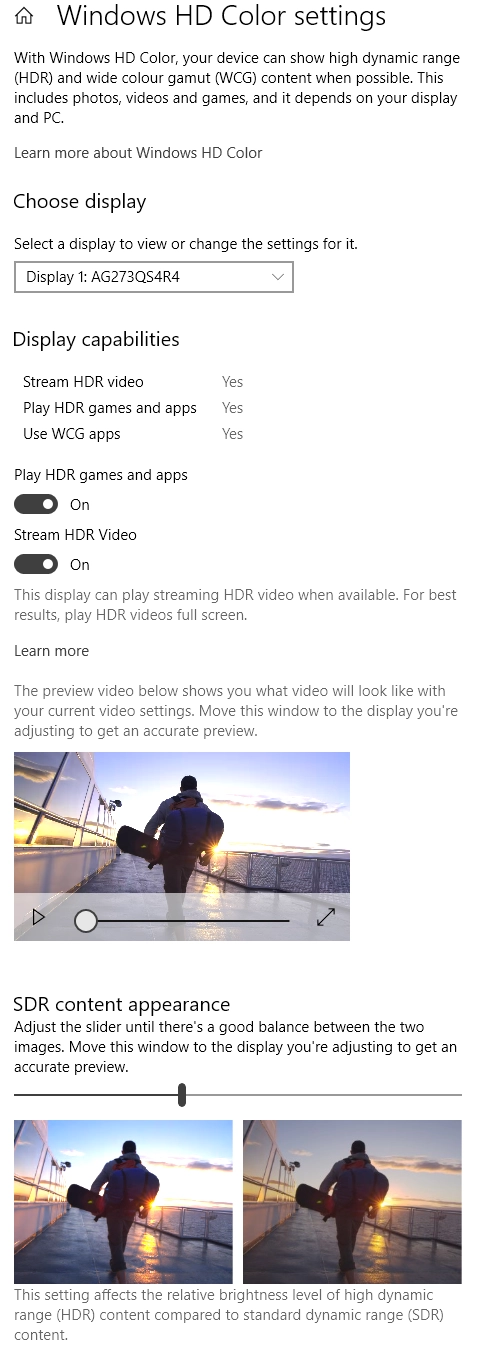
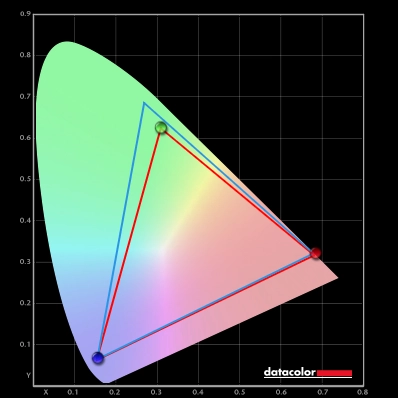
Colour gamut 'Test Settings'
The colour gamut of the monitor is also put to good use, as the DCI-P3 colour space is now the near-term target developers have in mind for HDR content rather than sRGB. The monitor’s gamut (red triangle above) is compared with the DCI-P3 colour space (blue triangle above), with 85% DCI-P3 coverage in this case. So not all shades had the vibrancy or intensity we’ve seen on some models under HDR. Some deep greens weren’t quite as lush as we’ve seen and some of Lara Croft’s attire on Shadow of the Tomb Raider includes some deep purple and blue dresses that weren’t as ostentatious as they could be. Not that they looked washed out, by any means. The representation of red-biased shades was quite pleasing under HDR, with roaring flames having the overdone red hues toned down and replaced with deep and vibrant oranges instead. Beyond the sRGB colour space and certainly vivid, but more appropriate and natural-looking than under SDR. Certain character skin tones and woody hues which had too much of a red hue were also toned down, which was nice to see.
Interpolation and upscaling

Video review
Timestamps:
Features & Aesthetics
Contrast
Colour reproduction
HDR (High Dynamic Range)
Responsiveness
Conclusion
Positives Negatives Fairly vibrant colour output, particularly for red shades, with effective sRGB emulation and excellent colour-consistency from the IPS panel Very basic HDR capability, no extended gamut support and calibration of our unit a bit off in terms of gamma Reasonable contrast, much as expected for the panel used, with a very light matte screen surface preserving clarity and vibrancy better than ‘stronger’ matte surfaces Some ‘misty’ graininess from the screen surface and a moderate amount of ‘IPS glow’ eating away at detail and atmosphere for darker content A respectable 60Hz performance overall, with fairly low input lag and decent overall pixel responsiveness Slight weaknesses in pixel responsiveness, including some ‘powdery’ trailing and minor overshoot, 60Hz refresh rate quite limiting and no Adaptive-Sync support Comfortable resolution and pixel density, solid build with good ergonomics and range of ports Priced higher than some competing models
As an Amazon Associate and Newegg Affiliate I earn from qualifying purchases made using the below link. Where possible, you’ll be redirected to your nearest store. Further information on supporting our work.



